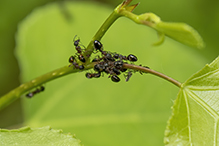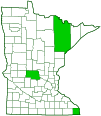mottled odorous ant
(Dolichoderus plagiatus)
Conservation • Description • Habitat • Ecology • Distribution • Taxonomy
|
|
||||||||||||||
Description |
Mottled odorous ant, also called mottled long-necked ant, is a medium-sized ant. It occurs in the United States from Maine to Maryland, west to North Dakota and Missouri, and south along the Appalachian Mountains to South Carolina. It occurs in southern Canada from Nova Scotia to Manitoba. Mottled odorous ants are found in open fields, in forests, and in the higher, drier areas of bogs and other wetlands. They typically form small colonies that consist of a single nest. The nests are hidden in clumps of grass, in the soil under leaf litter, in hollow stems of milkweed or dogbane, in hollowed-out twigs, and in dried and curled-up leaves. They have a single queen, and they usually have fewer than 100 workers. The workers prey on small invertebrates, they collect honeydew from aphids and scale insects, and they scavenge debris. Mottled odorous ants do not have a stinger. When disturbed, a defensive chemical compound is emitted from the anal gland, producing a pungent, often unpleasant odor. This is the feature that gives the Subfamily Dolichoderinae its common name. The worker is ⅛″ (3.5 to 4.0 mm) in length. The front part of the body is connected to the rear part by a single, distinct, narrow segment (petiole). There is no postpetiole. The head is slightly longer than wide. It is dark brownish black to nearly black. It has numerous erect hairs, and it is heavily sculptured with well-defined depressions. There are two large compound eyes on the sides of the head and three small simple eyes (ocelli) in a triangle on the top of the head. The antennae are dark brownish black to nearly black, they have 12 segments, and they are not clubbed at the end. The basal segment (scape) is very long. It is covered with short appressed hairs, and it has many short, fine, erect hairs. The remaining segments, collectively called the funiculus, join the scape at a sharp angle, giving the antennae a sharply elbowed look. The mandibles are dark brownish black to nearly black. The front part of the body (mesosoma) is orangish brown, becoming dark brown on older individuals. It is covered with sparse short hairs, it has numerous erect hairs, and it is heavily sculptured with well-defined depressions. The space within each depression is finely bumpy (granulated). There are three upper exoskeletal plates on the mesosoma, each forming a distinct bump. The first plate (pronotum) and second plate (mesonotum) cover the thorax. The mesonotum is as strongly sculptured as the pronotum. The third plate (propodeum) covers the first segment of the abdomen which is fused to the thorax. When viewed from above, the propodeum is longer than wide. When viewed from the side, it is distinctly raised and it is deeply concave in the rear, giving it the appearance of a bottle opener. This is an easily seen distinguishing feature of the genus. The petiole is dark orangish brown and has a single raised bump (node). The rear part of the body (gaster) is bulbous and mostly dark brownish black. The surface is highly reflective, and it has a few scattered erect hairs that are longer than those on the head and mesosoma. The first and second segments of the gaster have a pair of large yellowish brown to orangish brown patches that do not merge together. The legs are orangish brown. |
Size |
Total length – worker: ⅛″ (3.5 to 4.0 mm) |
Similar Species |
Habitat |
Open fields, in forests, and in the higher, drier areas of bogs and other wetlands |
Ecology |
Season |
May through September |
Behavior |
|
Life Cycle |
|
Larva Food |
|
Adult Food |
Small invertebrates, honeydew from aphids and scale insects, and debris |
Distribution |
||
|
Sources |
|
| 2/11/2025 | ||
Occurrence |
||
|
||
Taxonomy |
|
Order |
Hymenoptera (Ants, Bees, Wasps, and Sawflies) |
Suborder |
Apocrita (Narrow-waisted Wasps, Ants, and Bees) |
Infraorder |
Aculeata (Ants, Bees, and Stinging Wasps) |
Superfamily |
Formicoidea (ants) |
Family |
Formicidae (ants) |
Subfamily |
Dolichoderinae (odorous ants) |
Tribe |
Dolichoderini |
Genus |
Dolichoderus |
Subordinate Taxa |
|
|
|
Synonyms |
|
Dolichoderus borealis Dolichoderus plagiatus inornatus Hypoclinea plagiata |
|
Common Names |
|
mottled dolichoderus mottled long-necked ant mottled odorous ant |
|
Glossary
Gaster
The bulbous part of the abdomen of ants, bees, and wasps. In ants it usually begins at segment three.
Mesosoma
In Hymenoptera: the front part of the body, consisting of all three segments of the thorax and the first segment of the abdomen, to which the wings are attached.
Ocellus
Simple eye; an eye with a single lens. Plural: ocelli.
Petiole
On plants: The stalk of a leaf blade or a compound leaf that attaches it to the stem. On ants and wasps: The constricted first one or two segments of the rear part of the body.
Propodeum
In Hymenoptera: the last segment of the thorax, anatomically the first segment of the abdomen.
Scape
In plants: An erect, leafless stalk growing from the rootstock and supporting a flower or a flower cluster. In insects: The basal segment of the antenna.
Sculpturing
In ants: The pattern of raised and impressed features on the exoskeleton, including ridges, pits, lines, wrinkles, and granules (small bead-like bumps).
Tergite
The upper (dorsal), hardened plate on a segment of the thorax or abdomen of an arthropod or myriapod.
Visitor Photos |
||
Share your photo of this insect. |
||
This button not working for you? |
||
Greg Watson |
 |
The ants appear to be collecting honeydew from several scale insects. |
MinnesotaSeasons.com Photos |
||
|
||
|
||

Slideshows |
|

Visitor Videos |
||
Share your video of this insect. |
||
This button not working for you? |
||
|
Other Videos |
||
|

Visitor Sightings |
||
Report a sighting of this insect. |
||
This button not working for you? |
||
Greg Watson |
Location: Reno Quarry Trail in the Reno Recreation Area near Reno, MN The ants appear to be collecting honeydew from several scale insects. |
 |
MinnesotaSeasons.com Sightings |
||
|

|
Created: 2/11/2025 Last Updated: © MinnesotaSeasons.com. All rights reserved. |
